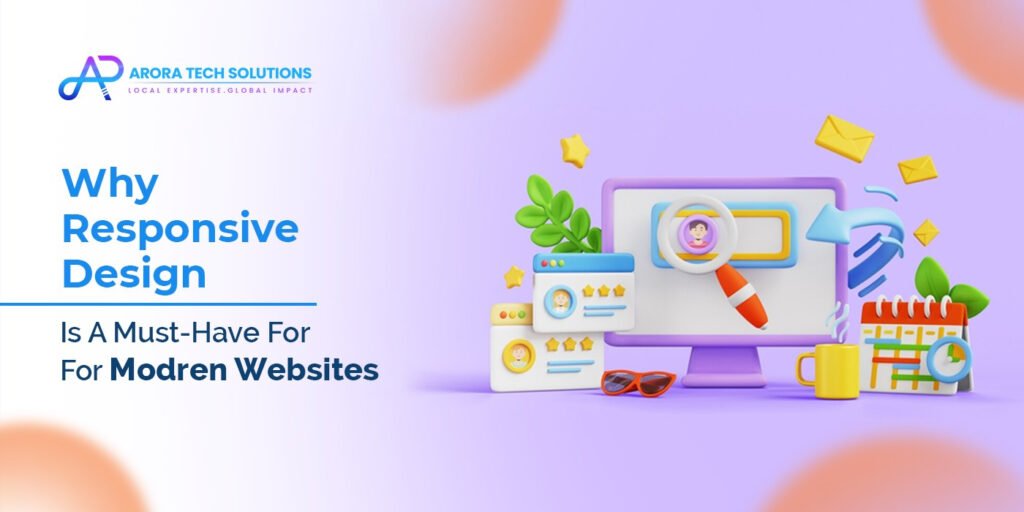Why Responsive Design Is a Must-Have for Modern Websites
Why Responsive Design Is a Must-Have for Modern Websites
In today’s digital age, where users access websites from various devices—smartphones, tablets, desktops, and laptops—ensuring that your website provides an optimal experience across all platforms is critical. This is where responsive design comes in. Responsive web design (RWD) is a web development approach that ensures your website looks and functions well on any screen size or device.
Let’s explore why responsive design is no longer just a nice-to-have feature, but a must-have for modern websites
1. Enhanced User Experience
Overview: User experience (UX) is a key factor in determining the success of a website. With a responsive design, your website automatically adjusts its layout, images, and content to fit the screen size, creating a seamless experience regardless of the device used.
Why It Matters:
- Improved Accessibility: A responsive design ensures that users don’t have to zoom in or scroll horizontally to view content on smaller screens, making navigation much easier.
- Faster Load Times: Responsive websites are optimized for speed, which directly impacts user satisfaction and retention.
- Consistent Experience: Whether a user is visiting your site on a phone, tablet, or desktop, the content and layout remain consistent, making for a smoother experience.
Impact in 2024: With more users relying on mobile devices to access the web, delivering a mobile-friendly, optimized experience is essential. A responsive design directly contributes to better UX and increased user engagement, making your website more user-centric.

2. Improved SEO Rankings
Overview: Search engines, particularly Google, prioritize mobile-friendly websites in their search results. Responsive design helps ensure your site ranks higher by providing a better user experience on mobile devices, which is a key factor for Google’s ranking algorithm.
Why It Matters:
- Mobile-First Indexing: Google uses mobile-first indexing, meaning it looks at the mobile version of your website first when determining rankings. A responsive website ensures that your site is optimized for mobile search.
- Lower Bounce Rates: Mobile-optimized websites typically experience lower bounce rates, as users can easily navigate and find what they’re looking for.
- Higher Engagement: Google values engagement signals like time spent on site and page views. With a responsive design, users are more likely to stay on your website longer, boosting these signals.
Impact in 2024: With SEO becoming more competitive, responsive design is essential for ranking well on search engines. It not only makes your website more accessible but also boosts its visibility and performance in search results.
3. Cost Efficiency and Easier Maintenance
Overview: In the past, businesses needed separate versions of their website for desktop and mobile users, which resulted in more complex development and higher maintenance costs. Responsive design eliminates the need for two separate sites, consolidating everything into a single website that works across all devices.
Why It Matters:
- Single Codebase: Maintaining one codebase for both mobile and desktop users makes development simpler and more cost-effective. Updates and changes are easier to manage since they only need to be made once.
- Lower Development Costs: Rather than paying for separate mobile and desktop websites, you only need to invest in one responsive website, reducing both development and maintenance expenses.
- Scalability: As new devices and screen sizes emerge, a responsive design automatically adapts, saving you from needing to redesign or develop new versions of your site.
Impact in 2024: With businesses looking to optimize their budgets, responsive design offers a cost-effective solution. It helps reduce expenses on maintenance, updates, and redesigns, while future-proofing your site against evolving tech trends.
4. Increased Mobile Traffic
Overview: Mobile traffic now surpasses desktop traffic in many parts of the world, with users increasingly relying on smartphones to browse the web. A responsive design ensures that your website caters to this growing audience by providing an easy-to-navigate, fast-loading experience on mobile devices.
Why It Matters:
- Reach More Customers: A responsive website allows you to reach a wider audience, including mobile users, who may otherwise be discouraged by a poor mobile experience.
- Competitive Advantage: As mobile usage continues to rise, responsive design ensures that you stay ahead of competitors who may not have optimized their websites for mobile.
Impact in 2024: With mobile internet usage showing no signs of slowing down, your website needs to be designed to meet the needs of mobile users. A responsive website ensures that you’re capturing this growing segment of the market.
5. Future-Proofing Your Website
Overview: As technology continues to advance, new devices with varying screen sizes will continue to emerge. A responsive design ensures that your website remains compatible with any new device, whether it’s a larger tablet, smaller smartphone, or wearable device.
Why It Matters:
- Adaptability: A responsive design automatically adjusts to different screen sizes and resolutions, meaning your website is future-proofed against emerging technologies.
- Long-Term Investment: Investing in responsive design now saves you from having to constantly redesign or update your website to keep up with new devices and user expectations.
Impact in 2024: In a fast-evolving technological landscape, ensuring your website can adapt to new devices and platforms is crucial. A responsive design makes your website scalable and ready for the future, without the need for constant redesigns.
Conclusion
Responsive design has become a non-negotiable feature for modern websites. It enhances user experience, boosts SEO performance, lowers costs, and ensures that your site can handle the increasing number of mobile and tablet users. In 2024, having a responsive website is essential for staying competitive, reaching a wider audience, and providing a seamless browsing experience across all devices. Whether you’re a small business owner or managing a large corporate site, responsive design will help you meet user expectations and improve the overall effectiveness of your website.




